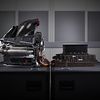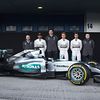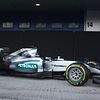Technical analysis: Mercedes F1 W06
Having utterly dominated the 2014 season, Mercedes had a big task over the winter to design a new car that could replicate that success. Still, rivals have reiterated over the winter that it would be extremely difficult to close the gap entirely, knowing that KERS and the turbo, the points pinned as Mercedes's strenghts have big lead times, and hence require time to improve.
Mercedes though is adamant none of those claims made the team rest on its laurels, and a closer look at their new F1 W06 appears to confirm that.
As changed regulations effectively outruled the team's 2014 concept - with a U-shaped cross section to meet the minimum dimensions - a different layout had to be devised. The team opted to retain a very short nose cone - possibly minimum length, as it hardly overlaps half of the front wing. The team also made the nose cone narrower to be less of a hindrance to airflow. To get this to fit in the rules, the tip had to be thickened slightly, at the same time making somewhat easier to fit a crash structure in it that is strong enough to meet the frontal impact test.
Paddy Lowe, in charge at Mercedes of the entire chassis design, said it continued to be the team's aim to keep the nose as short as possible, "with the mainplane of the wing as far forward of it as possible. This has produced a ‘clinging on by your fingernails’ kind of appearance where the wing attaches to the pillars, which is a big challenge to deliver structurally. Front wing stiffness tests today really do push the limits of engineering – particularly when coupled with the requirements of the front impact test."

The end result is a nose the is lower than in 2014, and with a largely identical upper profile of the monocoque, this means a steeper slope upwards. Careful though as the nose is actually thicker underneath than it may look like at first sight because the team did not paint the underside of the nose box silver, but instead black.
Having retained the position of the front bulkhead also allowed the team to more or less keep the same suspension mountings, and hence also the same layout. They simplifies progress and setup, as the centre of roll can stay the same. Still, Mercedes found a way to further improve its layout by moving the steering arm down, positioning it ahead of the lower wishbone, contrary to its alignment with the upper frontal wishbone as on the F1 W05.

This lower position results in a lower centre of gravity of the car itself, as the steering rack is lower down within the monocoque. It has also triggered the designing team to extract an aerodynamic advantage of it. As elements in this area are crucial for vortices coming off the front wing, the team clearly spent a lot of time designing that steering arm, shaping it like an aerofoil ahead of the wishbone and curving up to connect into the chassis just above the wishbone pickup point.
It may be that the removal of FRIC halfway through the 2015 season has cleared up the necessary room for this change and allowed other optimisitions, given that the suspension layout of the F1 W06 was designed around FRIC.
All things combined, this makes the upper wishbones look ridiculously simple compared to the Y-bone and steering arm that forms the lower elements of the front suspension.
In the same area, the car that debuted at Jerez also no longer had brake duct scoops with the team instead opting to catch all necessary air from in between the tyre wall and a vertical carbon fibre panel.
Further to the back, the sidepods now feature a horizontal vane of their entire width, a development from last year's car and a feature commonly seen on other cars as well. Along with the vortex generators fitted atop the sidepods, these items all attempt to optimise airflow onto the rear suspension and diffuser.

The airbox meanwhile has also been further developed, evolving into a design that provides less hindrance to airflow onto the rear wing. The ears have gone and the airbox channel bends down earlier. Just like with most other 2015 cars, the inlet is now divided into two parts, one to feed the turbo with another to provide cooling air to oil radiators or electrical components.
All other outer bodyparts at the rear of the car show how the F1W06 really is an evolution of its succesful predecessor. As the sidepods appear to have slimmed slightly, so have the sidepod air inlets. The hot air exits at the back of the car are largely the same, but can be expected to change in one of the next tests. The same goes for the rear and front wings, with in particular the rear wing being the same as the version ran last year during the Abu Dhabi young driver test after the end of the 2014 season.
Invisible to the eye are of course the enhancements that Mercedes have made to its already excellent power unit. Rumoured to be worth up to 50 additional horses compared to last year's engine, the design team of Andy Cowel in Brixworth likely kept the split turbine and turbo while integrating variable inlet trumpets for increased efficiency.
"We have been working hard on all areas of the Power Unit to increase the conversion efficiency of every single system", Cowell said.
"The focus in this respect has been on combustion efficiency and frictional losses – be they in core parts of the ICE or the ancillary aspects of both ICE and ERS. Development of fuel and lubricants has been critical to this process and we have continued working well with PETRONAS in this respect. There is very significant scope for change under the regulations and significant opportunities to make performance gains, so we have left no stone unturned in our quest for performance – and I am sure that exactly the same is true of our competitors."







